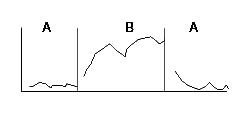

Home • Conference • News • Resources • Science • History • Autism • Bookshelf • Membership • Contact Us
Single-Subject Design Summary
The Multiple Baseline Design is used when a return to baseline is undesirable. Experimental control is demonstrated by the repeated changes in the dependent variable with each successive introduction of the independent variable. It protects against the inability of AB - type designs to demonstrate unequivocal control by the independent variable by showing the effects at different times. It is unlikely that a confound could repeatedly coincide with the introduction of the experimental variable. The effects of a confounding variable would be seen as a change in the behavior in all three baselines at the same time. The multiple baseline can be used across different subjects, settings, or responses. A standard variation of the design is the Staggered-Start Design in which a series of AB designs with equally long baselines are started at successive, overlapping times. If the target behavior is not irreversible, combining the multiple-baseline and reversal designs produces a highly effective demonstration of experimental control with multiple subjects, settings, or responses. The main disadvantage of the multiple baseline design is that a high degree of planning is required to produce a successful implementation.
The ABA or Reversal Design demonstrates the effect of the experimental variable by repeatedly introducing and withdrawing the experimental variable. Confidence in the demonstration of experimental control arises from the fact that confounds are unlikely to occur repeatedly at the same times as the experimental variable. The reversal design can be extended indefinitely. A standard variation is the BAB design. The main disadvantage of the ABA design is its inability to be used with variables with irreversible effects or when it is undesirable to return to a baseline condition for practical or ethical reasons.
The Multiple Sequential Withdrawal Design is a variation on the reversal design. It is used to separate the effects of each component of a compound independent variable. The components are presented individually and in combinations to determine their effects. Any number of components can be examined. The main disadvantages of the multiple sequential withdrawal design is the inability of the design to deal with variables with irreversible effects, the length of time required to examine several components, and difficulty interpreting order and interaction effects.
The Changing Criterion Design is used to determine the effects of an independent variable when the final version of the target behavior cannot be emitted initially. Experimental control is demonstrated by the repeated changes in the dependent measure as the criterion is changed. The steps in the changing criterion design must be large enough to clearly show the effects of the independent variable, but not so large that the subject cannot meet the changed criterion.
The Alternating Treatments Design is used to directly compare the effects of two or more different experimental variables across the same span of time in the same subject. It is also known as the multiple schedule design.It is also highly effective in controlling for systematic changes in the subject or setting across time. Its main disadvantages are (1) its inability to deal with irreversible effects, (2) potential generalization from one condition to the other, and (3) interpretation problems due a variety of interaction, carryover, and order effects.






AB Design
ABA/Reversal Design
Multiple-Sequential Withdrawal Design
Alternating Treatments/Multiple Schedule Design
Changing Criterion Design
Multiple Baseline Design
The AB Design can be used to quickly assess the effects of an experimental variable. Its main disadvantage its inability to distinguish the experimental effect from possible confounds that might occur coincident with the change of condition. A standard variation of the AB is the BA design in which a treatment is withdrawn to determine its effectiveness. Traditional psychologists call the AB design the "interrupted time-series design."
Behavior Analysis Association of Michigan, Department of Psychology, Eastern Michigan University, Ypsilanti, MI 48197